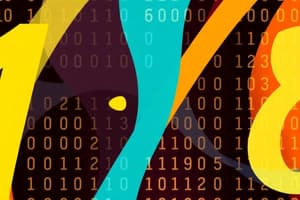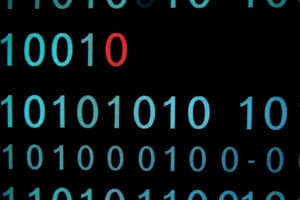Podcast
Questions and Answers
Which of the following are types of numeric data?
Which of the following are types of numeric data?
- Real (correct)
- Letters
- Symbols
- Integer (correct)
What is the definition of a positional number system?
What is the definition of a positional number system?
Each digit position has a value called a weight associated with it.
The base representing the Binary number system is ______.
The base representing the Binary number system is ______.
2
The Roman number system is a positional number system.
The Roman number system is a positional number system.
What is the binary representation of the decimal number 15?
What is the binary representation of the decimal number 15?
Convert the binary number 110110 to decimal.
Convert the binary number 110110 to decimal.
Match the number bases with their corresponding distinct symbols.
Match the number bases with their corresponding distinct symbols.
How do you convert the integer part of a decimal to a base R number?
How do you convert the integer part of a decimal to a base R number?
The 1's complement of the binary number 1010 is ______.
The 1's complement of the binary number 1010 is ______.
Which of the following conversions are correct?
Which of the following conversions are correct?
Flashcards are hidden until you start studying
Study Notes
Data Types
- Data is the information that a computer processes.
- Data can be numeric (like numbers) or Non-numeric (letters or symbols).
- Data structures organize data elements.
- Programs are instructions that tell the computer what to do with data.
Numeric Data Representation
- Numbers, including integers and real numbers, are examples of numeric data.
- Number systems are used to represent numbers.
- A positional number system assigns a value to each digit based on its position.
- The most common positional number systems are:
- Decimal (base 10) - Uses digits 0-9
- Binary (base 2) - Uses digits 0-1
- Octal (base 8) - Uses digits 0-7
- Hexadecimal (base 16) - Uses digits 0-9 and letters A-F
Conversion Between Number Systems
- Converting between base R and decimal involves:
- Base R to Decimal: Multiply each digit by its corresponding power of R and sum the results.
- Decimal to Base R:
- For the integer part: Repeatedly divide by R and accumulate the remainders.
- For the fractional part: Repeatedly multiply by R and accumulate the integer digits.
Complements
- Complements are used for representing negative numbers in computers.
- Two types of complements are used in base R:
- R's complement
- (R-1)'s complement
- (R-1)'s complement: Subtract each digit of a number from (R-1).
- For example, the 9's complement of 835 in decimal is 164.
Studying That Suits You
Use AI to generate personalized quizzes and flashcards to suit your learning preferences.




